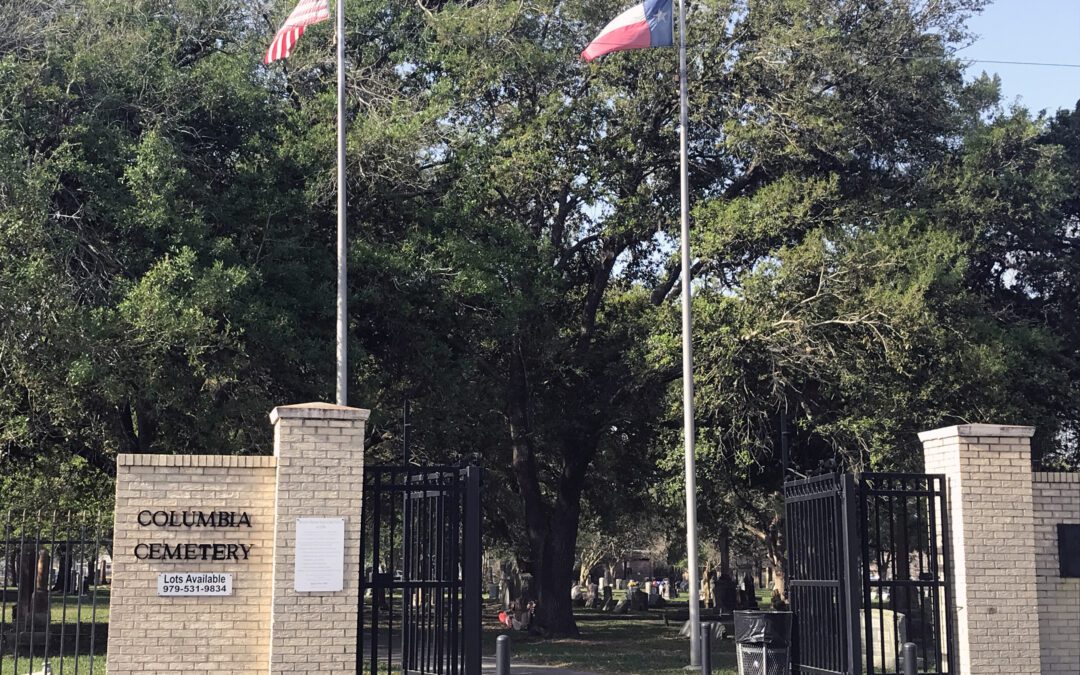![]()
By Tracy Gupton
Columbia Historical Museum Board Member
At the time of his death 122 years ago, William Henry Burkhart served as a Texas district judge longer than anyone else in the Lone Star State, according to The Houston Post. Judge Burkhart, who was buried at Columbia Cemetery in an unmarked grave following his passing February 22, 1900, at the age of 61, will be one of five former judges portrayed by actors at the Nov. 5 “Meet Your Ancestors” program at West Columbia’s historic cemetery.
The Columbia Historic Museum, in cooperation with the Columbia Cemetery Association, will be sponsoring the annual “Meet Your Ancestors” event which will begin at 5:30 p.m. on Saturday, Nov. 5. Admission to the program is free. Actors will portray the judges and tell a little bit about their character’s life story at the grave site.
And what an interesting story the actor portraying Judge Burkhart will have to tell. Born in Pennsylvania in 1838, he spent his boyhood days growing up in Matagorda on the Republic of Texas’s Gulf Coast. He studied law under the tutelage of his brother-in-law, D.E.E. Braman.
Although born in the north, Burkhart was a son of the south and dutifully volunteered for military service with the Confederate Army. At the conclusion of the Civil War in the mid-1860s, Burkhart returned home to Matagorda and served as county judge in neighboring Matagorda County.
After the Civil War, Burkhart aligned himself with the Republican party and was elected district judge in 1865, representing nine Texas Gulf Coast area counties including Matagorda and Brazoria counties. He officiated at many notable trials in Brazoria County during the next 27 years.
Noted local historians Marie Beth Jones, a current columnist for The Facts newspaper, and the late James A. Creighton, a former high school teacher in West Columbia, wrote about Judge Burkhart’s tenure on the bench.
Creighton said that Judge Burkhart presided at the 1892 murder trial of Frank Holland who had been accused of killing Steve Garvey, James Garvey and a man named Smith. Creighton wrote in “A Narrative History of Brazoria County,” (1975, Brazoria County Historical Commission) that Frank Holland’s execution was the first “legal” hanging in Brazoria County. Holland was led to the gallows outside the old courthouse in Brazoria on Feb. 2, 1893, and hanged under the supervision of Brazoria County Sheriff Robert M. Yerby, according to Creighton.
Jones writes in “Trials and Tribulations: Early Texas Crime Stories,” (2009) that Yerby “shot and killed himself in Williamson’s Saloon in Brazoria” on May 9, 1898, about two years after resigning as county sheriff due to a deep depression. Many who knew him well said he had been “despondent over his part in having hanged Frank Holland some five years earlier,” Jones wrote.
Holland, 23, and Jerome Baker, 15, were arrested in Luling in March 1892. They were accused of murdering three men. Holland was found guilty and given the death penalty in a trial Burkhart presided over. Jones wrote that Holland and Baker were seen riding horses away from a campsite at the mouth of the San Bernard River where the mutilated remains of three bodies were found.
When discovered, the limbs of the three men’s bodies had been cut off and each man had been beheaded, Jones writes in her book. Holland and Baker had been riding with the three murdered men when they stopped in Brazoria a few days earlier, witnesses testified at the 1892 trial. Baker and Holland were returned to Brazoria from Luling and placed in the county jail.
Burkhart presided over what Jones wrote had been “probably the most sensational ever tried in Brazoria. The old wooden courthouse was crowded with housewives and people who had never been in court before to hear the evidence.”
Because of his young age, Baker, who, like his accomplice Frank Holland was found guilty of murder in the first degree, received life in prison instead of the death penalty.
Burkhart also presided over the murder trial of Charley Davidson in 1892. Jones wrote that Davidson, a Black man, was found guilty of murdering Jim Jackson, a white employee of the Texas Prison System, on Dec. 15, 1890.
According to testimony, Jackson picked up money in Oyster Creek to be paid prison guards at the Retrieve Unit the same day he was killed. Jackson’s body was found lying in the road outside the gate at Retrieve with his horse standing nearby. The money was nowhere to be found.
The day after Jackson’s murder, Davidson was observed spending lots of money in a Brazoria mercantile and paid his mother’s taxes with a $5 gold piece like those Jackson had been in possession of at the time of his murder. Several witnesses testified that Davidson paid them money he owed them the day after Jackson’s murder.
When Yerby searched for Davidson to arrest him, he was eventually found in Brazoria spending money freely, according to Jones’ book. Davidson was found guilty, and Burkhart sentenced him to life in prison.

Judge William Henry Burkhart is buried at Columbia Cemetery in an unmarked grave. He was a district judge for 27 years in Brazoria and Matagorda counties.

William Henry Burkhart Jr. was the son of Judge William Henry Burkhart. He was postmaster in Columbia, Texas, in 1900 at the time of his father’s death.

